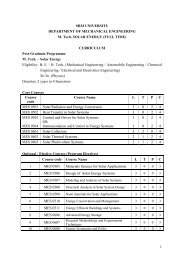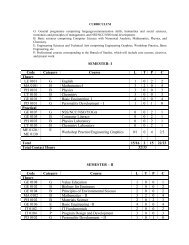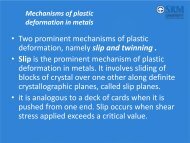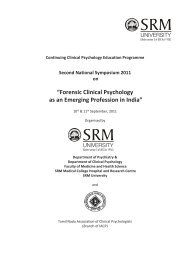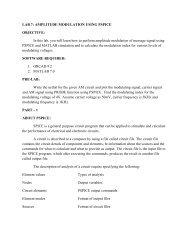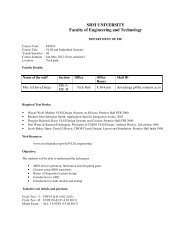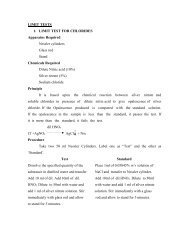RADIATION SAFETY
RADIATION SAFETY
RADIATION SAFETY
You also want an ePaper? Increase the reach of your titles
YUMPU automatically turns print PDFs into web optimized ePapers that Google loves.
<strong>RADIATION</strong> <strong>SAFETY</strong><br />
IN<br />
DIAGNOSTIC RADIOLOGY<br />
M.ANANTHI<br />
ASSISTANT PROFESSOR<br />
RADIOLOGICAL PHYSICS<br />
DEPARTMENT OF RADIOLOGY<br />
SRM MEDICAL COLLEGE HOSPITAL & RESEARCH<br />
CENTRE, POTHERI
INTRODUCTION<br />
• Medical imaging of the human body requires some form of<br />
energy.<br />
• In radiology, the energy used to produce the image must<br />
be capable of penetrating tissues.<br />
• Visible light - limited ability to penetrate tissues at<br />
depth.<br />
• Visible light images are used in dermatology (skin<br />
photography), gastroenterology and obstetrics<br />
(endoscopy), and pathology(light microscopy).<br />
• All disciplines in medicine use direct visual observation<br />
utilizing the visible light.
• In diagnostic radiology, the electromagnetic spectrum<br />
outside the visible region is used for x- ray imaging,<br />
including mammography and computed tomography,<br />
magnetic resonance imaging and nuclear medicine.<br />
• Mechanical energy in the form of high – frequency<br />
sound waves, is used in ultrasound imaging.<br />
• In nuclear medicine imaging, the radioactive agents are<br />
injected or ingested and it is the metabolic or<br />
physiologic interactions of the agent that give rise to<br />
the information in the images.
• The diagnostic utility of a medical image relates to<br />
both technical quality of the image and the conditions<br />
of its acquisitions.<br />
• Consequently, the image quality that is obtained from<br />
medical imaging devices involves compromise.<br />
Better x – ray images can be made when the<br />
radiation dose to the patient is high,<br />
Better magnetic resonance images can be made when<br />
the image acquisition time is long and<br />
Better ultrasound images result when the ultrasound<br />
power levels are large.
• Patient safety and comfort must be<br />
considered when acquiring medical images.<br />
• There should be a balance between patient<br />
safety and image quality.
<strong>RADIATION</strong><br />
• Radiation is small pockets<br />
of energy, which travels<br />
as waves and transfer<br />
energy from one point to<br />
another.<br />
• Types of Radiation:-<br />
1. Photons<br />
( E.g.) X & rays<br />
2. Particles<br />
( E.g.) e, p, n, & α
ELECTROMAGNETIC<br />
<strong>RADIATION</strong>
ELECTROMAGNETIC<br />
<strong>RADIATION</strong><br />
PROPERTIES<br />
• No mass and no charge.<br />
• Unaffected by either electrical or magnetic fields.<br />
• Constant speed in a given medium.<br />
• Does not require any material medium for its propagation.<br />
• Travels with the velocity of light (2.998 x 10 8 m/sec).<br />
• Travels in straight line.<br />
• Interaction with matter occurs either by absorption or<br />
scattering.
ELECTROMAGNETIC<br />
<strong>RADIATION</strong><br />
DUAL NATURE OF EM <strong>RADIATION</strong><br />
• Waves<br />
• Particle like units of energy called<br />
photons or quanta.
• Waves characterized by amplitude, wavelength (λ),<br />
frequency (ν), and period<br />
• Speed (c), wavelength, and frequency related by<br />
c<br />
= λν<br />
• Wavelengths typically measured in nanometers (10 -<br />
9<br />
m); frequency expressed in hertz (Hz) (1 Hz = 1<br />
cycle/sec = 1 sec -1 )
EM Wave Characteristics
• When interacting with matter, EM radiation<br />
can exhibit particle-like behavior<br />
• Particle-like bundles of energy called photons;<br />
energy is given by<br />
E = hν = hc /<br />
where h = 6.62 x 10 -34 J-sec<br />
• Energies of photons commonly expressed in<br />
electron volts (eV)<br />
λ
• EM radiation of higher frequency than near-ultraviolet<br />
region of spectrum carries enough energy per photon to<br />
remove bound electrons from atomic shells, producing<br />
ionized atoms and molecules.<br />
Radiation in this region is called ionizing radiation<br />
Eg. UV radiation, X – Rays, Gamma rays etc.<br />
• Visible light, infrared, radio and TV broadcasts are<br />
called non ionizing radiation
ELECTROMAGNETIC<br />
<strong>RADIATION</strong>
• Protons – found in nuclei of all atoms; single positive<br />
charge<br />
• Electrons – exist in atomic orbits; emitted by nuclei<br />
of some radioactive atoms (referred to as beta-minus<br />
particles (β - ), negatrons, or simply “beta particles”)<br />
• Positrons – positively charged electrons (β + ); emitted<br />
from some nuclei during radioactive decay<br />
• Neutrons – uncharged nuclear particle; released by<br />
nuclear fission and used for radionuclide production
• Einstein’s theory of relativity states that<br />
mass and energy are interchangeable<br />
where E represents the energy equivalent<br />
to mass m at rest and c is the speed of<br />
light in a vacuum<br />
2<br />
E = mc
Particle<br />
Symbol<br />
Relative<br />
Charge<br />
Approx. E<br />
(MeV)<br />
Proton p +1 938<br />
Electron e - -1 0.511<br />
Positron e + +1 0.511<br />
Neutron n 0 940
INTERACTION OF X-RAY<br />
WITH MATTER<br />
TYPES OF INTERACTION<br />
• Coherent scattering<br />
• Photoelectric absorption<br />
• Compton scattering<br />
• Pair production<br />
• Photodisintegration
• Photoelectric absorption<br />
• Compton scattering
• In the Compton effect, the<br />
incident X-ray interacts with an<br />
outer shell electron and ejects it<br />
from the atom, thereby ionizing<br />
the atom
• Probability of Compton interaction decreases with as<br />
the X-ray energy increases (∝1/E)<br />
• Probability of Compton effect does not depend on the<br />
atomic number<br />
• It occurs in all energies in tissue, important in X-ray<br />
imaging<br />
• Predominant interaction in the diagnostic energy range<br />
with soft tissue (100keV-10MeV)
• Photon (X-rays) interacts with inner shell electrons<br />
and it is totally absorbed<br />
• An electron is removed from the atom, called a<br />
photoelectron
PHOTOELECTRIC EFFECT<br />
• The probability of photoelectric interaction is a<br />
function of both x-ray energy and atomic number<br />
of the interacting atom<br />
• Probability of P.E.∝ 1/E 3<br />
• The x-ray energy should be equal or greater than<br />
the electron binding energy (max probability)<br />
• Probability of P.E.∝ Z 3<br />
• Photoelectric interaction is much more likely to<br />
occur with high Z atoms than with low Z
RADIATON UNITS<br />
Quantity SI Unit Non-SI Unit<br />
Exposure C/kg Roentgen (R)<br />
Absorbed dose gray (J/kg) rad<br />
Equivalent dose sievert Rem<br />
Activity becquerel curie
BIOLOGICAL EFFECTS OF<br />
<strong>RADIATION</strong><br />
• Radiation deposits energy in tissues<br />
• randomly and rapidly (
BIOLOGICAL EFFECTS<br />
– Stoppage of Cell Division<br />
• Inhibition of mitosis can be temprary or<br />
permanent depending on the severity of the<br />
radiation dose and Dose rate<br />
– Chromosomal aberration<br />
• Breakage in chromosomes – result in some<br />
part of the genetic material not being<br />
transferred to daughter cell.<br />
• Biological Indicator<br />
• Employed for Dosimetry to ascertain the<br />
genuineness of radiation exposure
BIOLOGICAL EFFECTS<br />
– Gene mutation<br />
• Change in structure and characteristics<br />
of the gene – genetic effects<br />
– Cell Death<br />
• Death of cell due to changes in the<br />
physical properties of vital cell<br />
structure<br />
Latent period : minutes - years
LAW OF BERGONE &<br />
TRIBONDEAU (1906)<br />
• Radiosensitivity was a function of the metabolic state<br />
of the tissue being irradiated<br />
• Stem cells (immature) are radiosensitive ; mature cells<br />
are radioresistant<br />
• Younger tissues and organs are radiosensitive<br />
• Tissues with high metabolic activity are radiosensitive<br />
• Cells with high proliferation rate & tissues with high<br />
growth rate are radiosensitive
RADIOSENSITIVITY OF CELL<br />
Radiosensitiv<br />
ity<br />
Cell type<br />
High Lympocytes,<br />
Spermatogonia,<br />
Erythroblasts,<br />
intestinal cells<br />
Intermediate Endothelial cells,<br />
Osteoblasts,<br />
Fibroblasts<br />
Low<br />
Muscle cells,<br />
Nerve cells
BIOLOGICAL EFFECTS
BIOLOGICAL EFFECTS<br />
• Direct & Indirect interaction<br />
• Direct Action – The sensitive volume in the<br />
cell is changed / inactivated by the direct<br />
absorption of energy from radiation.<br />
• Indirect Action – The sensitive volume is<br />
inactivated by transfer of energy from<br />
another volume which has directly or<br />
indirectly absorbed energy from radiation.<br />
- Water molecule
BIO EFFECTS:WATER<br />
• H 2 O → H 2 O + , H 2 O - ion pairs<br />
• H2O+ → H+ + OH*<br />
• H2O- → H*+ OH-<br />
• OH*+OH*=H2O2 (hydrogen peroxide)<br />
• H*+O2=HO2* (Hydroperoxyl radical)
BIOLOGICAL EFFECTS<br />
• Somatic Effects<br />
– Manifest in the individual exposed to<br />
radiation<br />
• Genetic Effects<br />
– Manifest in the future generations<br />
of persons exposed to radiation –<br />
Hereditary effects
Biological effects may result from<br />
• Acute Exposures – High exposure in short<br />
periods<br />
• Chronic exposures – Small exposures over<br />
long period
Biological effects may also be<br />
classified as<br />
• Immediate effects – within a few<br />
weeks of exposure<br />
• Delayed effects – after a few<br />
Immediate effects ( Acute<br />
years<br />
exposure)<br />
Delayed effects (Chronic or<br />
acute exposure)<br />
Chromosome aberration<br />
Blood changes Nausea<br />
Vomitting<br />
Diarrhea<br />
Radiation Sickness<br />
Epilation<br />
Skin erythema<br />
Sterility<br />
Death<br />
Cancer<br />
Leukaemia<br />
Cataract<br />
Hereditary effects
BIOLOGIAL EFFECTS<br />
Biologic effects<br />
(i).Deterministic effect<br />
(ii).Stochastic effects
DETERMINISTIC EFFECTS<br />
• A deterministic effect is one “which<br />
increases in severity with increasing<br />
absorbed dose in affected individuals”<br />
• Appear at higher doses (>0.5 Gy)<br />
• Cell killing→degenerative changes in the<br />
exposed tissues<br />
• Soon after the dose is received
DETERMINISTIC EFFECTS<br />
• Have threshold dose, below which the<br />
effect is not seen<br />
• Likely in Radiation accidents and<br />
patients irradiated in radiotherapy<br />
• Unlikely in diagnostic Radiology (both<br />
procedures and occupation)
DETERMINISTIC<br />
EFFECTS<br />
• Skin erythema,<br />
• epilation,<br />
• organ atrophy,<br />
• fibrosis,<br />
• cataract,<br />
• blood changes,<br />
• reduction in sperm count etc.,
STOCHASTIC EFFECT<br />
• A stochastic effect is one in which “the<br />
probability of occurrence increases with<br />
increasing absorbed dose rather than its<br />
severity”<br />
• Important at very low levels:
STOCHASTIC EFFECT<br />
• Seen only at a later period (10-30 years)<br />
• Independent of sex and age<br />
• E.g., carcinogenesis and genetic effects<br />
• Likely in diagnostic radiology & Nuclear<br />
medicine (low dose radiation)
<strong>RADIATION</strong> & PREGNANCY<br />
• Radiation effects before, during and after pregnancy<br />
• Interrupted fertility, congenital effects, Genetic<br />
effects<br />
• Pre implantation, major organogenesis, fetus<br />
• First trimester is the most radiosensitive period<br />
• Low dose, chronic irradiation does not impair fertility
<strong>RADIATION</strong> & PREGNANCY<br />
• In utero: Prenatal death, neonatal death, congenital<br />
abnormalities, malignancy induction, impairment of<br />
growth, genetic effects, mental retardation
<strong>RADIATION</strong> & PREGNANCY<br />
• It is unlikely that radiation from diagnostic x-ray<br />
examinations will result in any deleterious effects on<br />
the child, but possibility of a radiation induced effect<br />
cannot be entirely ruled out.<br />
• Continue work in x-ray, as long as fetal dose < 1mGy<br />
• Termination of pregnancy
BIOLOGIAL EFFECTS &<br />
FACTORS<br />
• Radiation type<br />
• Dose<br />
• Dose rate<br />
• Dose fractionation<br />
• Age<br />
• Nature of exposure: whole/partial<br />
• Cell cycle<br />
• Radio-protectors /sensitizers
<strong>SAFETY</strong> OBJECTIVE<br />
• Prevent the occurrence of deterministic<br />
effects<br />
• Minimize the occurrence of stochastic<br />
effects<br />
• Keep exposures as low as reasonably<br />
achievable (ALARA)
<strong>RADIATION</strong> EFFECTS
ANNUAL FATALITY RATE<br />
NCRP‐91(1987)<br />
Occupation<br />
Fatal accident<br />
rate/10,000<br />
Trade 0.5<br />
Manufacturing 0.6<br />
Government 0.9<br />
Transport 2.7<br />
Construction 3.9<br />
Agriculture 4.6<br />
Mining, Quarrying 6.0<br />
Radiation 0.3
REGULATIONS<br />
• International Commission on Radiological Protection<br />
(ICRP)-1928<br />
• DRP / RPAD, BARC-1953<br />
• Atomic Energy Act-1962<br />
• Atomic Energy Regulatory Board (AERB)-1983<br />
• Atomic energy (Radiation Protection) Rules -2004
PRINCIPLES OF<br />
RADIOLOGICAL<br />
PROTECTION<br />
• The Justification of practice<br />
• The Optimization of Protection<br />
• Dose limits<br />
Ref: Annals of ICRP-103
JUSTIFICATION<br />
• All exposure either diagnostic or therapeutic shall<br />
be under taken if the benefit gained out weighs<br />
the detriment.<br />
• No practice shall be adopted unless it produces a<br />
net positive benefit
OPTIMIZATION<br />
• All exposures which are justified shall be under<br />
taken with a minimum possible dose<br />
• Every effort shall be taken to reduce the dose to<br />
As Low As Reasonably Achievable (ALARA)
DOSE LIMITS<br />
• The equivalent doses to individuals result in from above<br />
practices should be subjected to dose equivalent limits.<br />
• These are aimed at ensuring that no individual is<br />
expected to radiation risks that are judged to be<br />
unacceptable from these practices in normal<br />
circumstances.
DOSE LIMITS<br />
Application<br />
Occupational,m<br />
Sv/year<br />
Public,<br />
mSv/year<br />
Effective Dose 20 1<br />
Eye Lens 150 15<br />
Skin 500 50<br />
Hands & Feet 500 50
<strong>RADIATION</strong><br />
EXPOSURE<br />
CONTROL<br />
Four principal methods by which radiation<br />
exposures to persons can be minimized<br />
• Time<br />
• Distance<br />
• Shielding<br />
• Contamination control
TIME<br />
• Total dose received by a radiation worker is directly<br />
proportional to the total time spent in handling the<br />
radiation source<br />
• Lesser the time spent near the radiation source, lesser<br />
will be the radiation dose<br />
• As the time spent in the radiation field increases, the<br />
radiation dose received also increases
TIME<br />
• Hence minimize the time spent in any radiation area<br />
• Techniques to minimize time in a radiation field should<br />
be recognized or practiced<br />
• Diagnostic x-ray machines typically produce high<br />
exposure rates over brief time intervals
DISTANCE<br />
• Radiation intensity decreases with distance, due to<br />
divergence of the beam<br />
• It is governed by the inverse square law<br />
• The exposure rate from a point source of radiation<br />
is inversely proportional to the square of the<br />
distance
DISTANCE<br />
• If the exposure rate is X 1 at distance d 1 ,then the<br />
exposure rate X 2 at another distance d 2 is given by<br />
X 2 =X 1 (d 1 /d 2 ) 2<br />
• Doubling the distance from the x-ray source decreases<br />
the x-ray beam intensity by a factor of 4<br />
• Larger the distance, lesser will be the radiation dose
SHIELDING<br />
• When maximum distance and minimum time do not<br />
ensure an acceptably low radiation dose, adequate<br />
shielding must be provided, so that radiation beam will<br />
be sufficiently attenuated<br />
• Material that attenuates the radiation exponentially is<br />
called a shield<br />
• Shield will reduce exposure to patients, staff and the<br />
public.
SHIELDING<br />
• The reduction in intensity depends upon the nature<br />
and thickness of the shield and energy of the<br />
radiation<br />
• Thicker the shielding, lesser the radiation<br />
• Lead and concrete are the most commonly used<br />
materials for shielding<br />
• Lead aprons, gonad shield, lead gloves and lead<br />
bricks are also used as shield
LEAD APRON
THYROID SHIELD
LEAD GLOVES
<strong>RADIATION</strong> MONITORING<br />
• Radiation exposure must be monitored<br />
for both safety & regulatory purposes<br />
• This assessment need to be made over<br />
a period of several months (3 months)<br />
• Personnel Monitoring<br />
• Area monitoring
PERSONNEL MONITORING<br />
Three types of radiation recording<br />
devices<br />
• Film badge<br />
• Thermoluminescent dosimeter (TLD)<br />
• Pocket dosimeter
• Monitor & control individual doses regularly in order to<br />
ensure compliance with stipulated dose limits<br />
• Report & investigate over exposures & recommend<br />
necessary remedial measures urgently<br />
• Maintain life time cumulative dose records of the users<br />
of the service
• Personnel Monitoring provides<br />
(i) Occupational absorbed dose information<br />
(ii) Assurance that dose limits are not exceeded<br />
(iii) Trends in exposure to serve as check on<br />
working practice
THERMOLUMINESC<br />
ENT DOSIMETER<br />
(TLD)<br />
• TLD consists of plastic cassette with nickel coated<br />
aluminum card<br />
• The card is provided with three holes<br />
• Each hole is fitted with discs of CaSo 4 :Dy in Teflon<br />
matrix<br />
• Disc dimension: 0.8 mm thick and 13.5 mm dia.<br />
• Card is enclosed by a paper wrapper
THERMOLUMINESC<br />
ENT DOSIMEER<br />
(TLD)<br />
• When TLD material is exposed to ionizing radiation,<br />
fraction of the electrons are raised to exited states<br />
and trapped there.<br />
• By heating, these trapped electrons are released<br />
• Electrons fall to low energy states with emission of<br />
light<br />
• Light emission is proportional to radiation exposure
THERMOLUMINESC<br />
ENT DOSIMETER<br />
(TLD)
POCKET DOSIMETER<br />
• Film and TLD will not show<br />
accumulated exposure<br />
immediately<br />
• Pocket dosimeter gives<br />
instantaneous radiation<br />
exposure<br />
• Useful in non-routine work, in<br />
which radiation levels vary<br />
considerably (cardiac cath lab)<br />
• Dose can be read off directly<br />
by the person after any<br />
radiation work
AREA<br />
MONITORING<br />
• The assessment of radiation levels at different<br />
locations in the vicinity of radiation installation is<br />
known as area monitoring or radiation survey<br />
• These measurements will give an idea about the<br />
radiation status of the installation
AREA MONITORING<br />
• On the basis of measurements taken, one could confirm<br />
the adequacy or inadequacy of the existing radiation<br />
protection status<br />
• In case the radiation levels are found to be higher than<br />
the permissible levels, suitable remedial measures can<br />
be taken<br />
• Instruments used for the above purposes are called<br />
area monitors or radiation survey meters
<strong>RADIATION</strong><br />
SURVEY METRS<br />
• Ionization type survey meter<br />
• Geigher-Muller (GM) type<br />
• Gamma zone monitor<br />
• Contamination monitor
WARNING LIGHT & PLACARD<br />
• A suitable warning signal<br />
such as red light.<br />
• An appropriate warning<br />
placard shall also be<br />
posted outside the x-ray<br />
room




